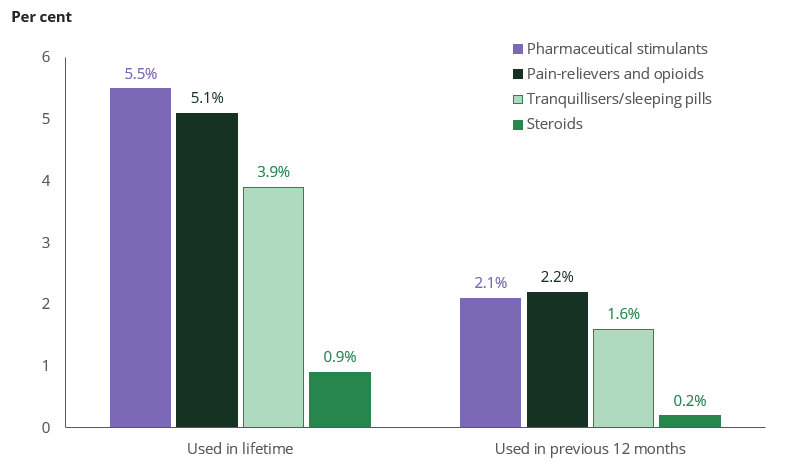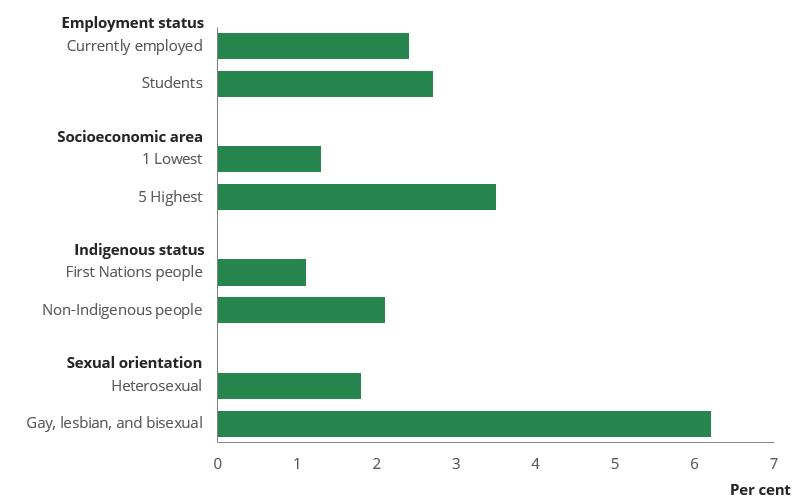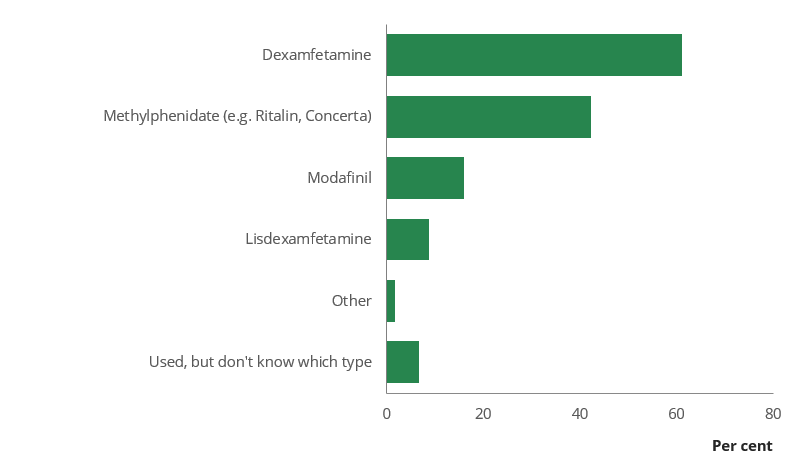Non‑medical use of pharmaceutical stimulants in Australia
Pharmaceutical stimulants
Pharmaceutical stimulants are medications that are usually prescribed to treat attention deficit hyperactivity disorder (ADHD) or narcolepsy. These medications require a prescription from a medical professional to obtain legally. Commonly prescribed pharmaceutical stimulants include methylphenidate (for example, Ritalin, Concerta), modafinil (for example, Modavigil), lisdexamfetamine (for example, Vyvanse) and Dexamfetamine (Jones and Sutherland 2022).
The NDSHS first asked about non‑medical use of pharmaceutical stimulants in 2022–2023, as previously they were included in a section that combined pharmaceutical stimulants and other stimulants such as methamphetamine.
Non‑medical use of pharmaceutical stimulants
In the NDSHS, non‑medical use refers to using the drug for recreational purposes (to induce or enhance a drug experience) or using a drug in a way that it was not prescribed/recommended (for example, for weight loss or performance enhancement).
People who use pharmaceutical stimulants for non‑medical purposes may have the goal of increasing alertness, concentration and memory, or of inducing a drug experience, whether or not there is evidence of these drugs being effective in doing so when not prescribed. Individuals are likely to have their own reasons for using pharmaceutical stimulants (Jones and Sutherland 2022).
In 2022–2023, 5.5% of people reported having used a pharmaceutical stimulant for non‑medical purposes in their lifetime, equating to about 1.2 million people in Australia. More people had used pharmaceutical stimulants for non‑medical purposes in their lifetime than any other pharmaceutical, including pain-relievers and opioids (Figure 1).
About 400,000 people in Australia (2.1%) had used pharmaceutical stimulants for non‑medical purposes in the previous 12 months, meaning illicit use was higher than inhalants (for example, happy gas, nangs, petrol), ketamine, and methamphetamine and amphetamine.

Note: People could select multiple responses.
Source: NDSHS 2022–2023, Tables 6.1 and 6.2.
As with most illicit drugs, people in their 20s were the most likely to have used pharmaceutical stimulants for non‑medical purposes in the previous 12 months (4.8%) and males (2.5%) were more likely to have done so that females (1.5%).
Who was most likely to use pharmaceutical stimulants?
Typically, students were less likely to have used illicit drugs in the previous 12 months than people who were currently employed. For example, currently employed people were 1.9 times as likely to have used cocaine as students, and 1.1 times as likely to have used cannabis.
However, students were 1.1 times as likely to have used pharmaceutical stimulants in the previous 12 months as people who were currently employed, and 1.3 times as likely as all people to have done so.

(a) Used in the previous 12 months.
Notes
1. Rates for First Nations people should not be directly compared to rates for non‑Indigenous people due to differences in the age structures between the two populations. Age standardised results can be found in the supplementary data tables.
2. ‘Students’ includes people who nominated their “Main current employment status” as “A student”. This is likely to include people in tertiary and vocational education as well as those in secondary school aged 14 and over.
Source: NDSHS 2022–2023, Table 6.21.
As with many illicit drugs, recent non‑medical use of pharmaceutical stimulants was not the same across all populations (Figure 2). In particular:
- In 2022–2023, 6.2% of gay, lesbian, and bisexual people had used them in the previous 12 months. After adjusting for differences in age, gay, lesbian, and bisexual people were 3.0 times as likely to have used them as heterosexual people.
- People living in the most advantaged socioeconomic areas were 2.7 times as likely to have used them as people in the most disadvantaged socioeconomic areas.
- In 2022–2023, *1.1% of Aboriginal and Torres Strait Islander (First Nations) people had used pharmaceutical stimulants for non‑medical purposes. After adjusting for differences in age, non‑Indigenous people were 2.6 times as likely to have done so as First Nations people.
* Estimate has a relative standard error between 25% and 50% and should be interpreted with caution.
People who had recently used pharmaceutical stimulants for non‑medical purposes also tended to be experiencing higher levels of psychological distress than people who had not done so. Over 2 in 5 (41%) people who had done so were experiencing high or very high levels of psychological distress, compared with 16.1% of people who had not done so.
Which pharmaceutical stimulants were the most commonly used in 2022–2023?
Some pharmaceuticals are used more commonly for non‑medical purposes than others. These differences may reflect preferences for the non‑medical use of certain drugs but are also likely to reflect the availability of different drugs.
Among those who had used pharmaceutical stimulants for non‑medical purposes in the previous 12 months, the majority had used dexamfetamine (3 in 5 people, 61%), and the next most used form was methylphenidate (2 in 5 people, 42%) (Figure 3).
A small portion of people (6.5%) reported that they had used a pharmaceutical stimulant but were unsure which form they had used.

Source: NDSHS 2022–2023, Table 6.20.


